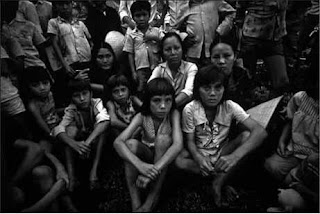 |
| Bill Kurtis: New York Times Magazine |
 |
| Bill Kurtis: New York Times Magazine |
Vietnamese Amerasian Timeline
Year Event
| May 1954 | Vietnamese defeat French in the battle of Dien Bien Phu to gain their independence. |
| Nov. 1955 | The Viet Nam War begins |
| 1961 | President Kennedy increases the number of American advisors in South Viet Nam. |
| 1973 | U.S. pulls out a majority of their troops through Vietnamization. |
| March 1975 | Operation Babylift airlifted approximately 2000 Vietnamese orphans out of Viet Nam and brought them to adopted families in the United States. Among them are several hundred Amerasian orphans. |
| April 30, 1975 | The Viet Nam War ends as South Viet Nam’s capital, Sai Gon, falls to Communist North. South Viet Nam and North Viet Nam and united into |
| 1975 | The United States places an embargo against Viet Nam. The nation prohibited Americans from sending money, mail, and humanitarian aid to Viet Nam, which in turn caused American servicemen who had fathered Amerasians children to lose contact with their family in Viet Nam. In addition, the U.S. vetoed Viet Nam’s bid to join the United Nations. |
| 1979 | Passage of the Orderly Departure Program (ODP). ODP created an alternative to fleeing by boat for impoverished and politically oppressed Vietnamese falling the fall of Sai Gon. After the applicants were accepted, they would be sent to one of 40 receiving countries. |
| 1982 | Congress passes the Amerasian Immigration act to allow Amerasians throughout southeast Asia immigrate to the U.S. and live with sponsor families. The act was partially passed in response to TV Journalist Bill Kurtis’ documents of the overwhelming number of Amerasian street children he encountered in 1980 after coming back to Viet Nam to study Agent Orange (Lipman: See below). Bureaucracy because of the two nations’ strained relationship, and the lack of U.S. officials in Viet Nam to conduct interviews, however, made the efforts futile. |
| Dec. 1987 | The Amerasian Homecoming Act is passed. The act allows Amerasians fathered by U.S. servicemen between 1962 and 1976 and members of their immediate family to emigrate to the United States. |
| 1989- 1994 | Emigration of Amerasians and their family. Amerasian applicants are interviewed by the Immigration and Naturalization Services (INS). They then pass through the Philippine Refugee Processing Center (PRPC) for approximately 6 months and are typically relocated to one of the 55 cluster sites for Vietnamese Amerasians in the United States. Toward the latter end of the program, some Amerasians were sent directly to the United States where they became acculturated in Refugee Centers which offered them many of the same services as PRPC did. |
| Oct. 1993 | Federal funding for Amerasian resettlement ends. The number of overall Amerasians and their families who settled in the U.S. through the Homecoming Act recorded range from 70,000- 100,000. A small number of Vietnamese Amerasians continue to emigrate to the United States annually. |
| Feb. 1994 | President Clinton ends the U.S. embargo in Viet Nam and the two nations begin to normalize their relationship. |
-Kurtis, Bill. “The Plight of the Children Abandoned in Vietnam,” New York Times Magazine, March 2, 1980
Jana K. Lipman. ""The Face Is the Road Map": Vietnamese Amerasians in U.S. Political and Popular Culture, 1980–1988." Journal of Asian American Studies 14.1 (2011): 33-68. Project MUSE. Web. 28 Feb. 2011. <http://muse.jhu.edu/>.
Jana K. Lipman. ""The Face Is the Road Map": Vietnamese Amerasians in U.S. Political and Popular Culture, 1980–1988." Journal of Asian American Studies 14.1 (2011): 33-68. Project MUSE. Web. 28 Feb. 2011. <http://muse.jhu.edu/>.
-Yarborough, Trin. Surviving Twice: Amerasian Children of the Vietnam War. 2006. Washington D.C. :Potomac Books. Print.